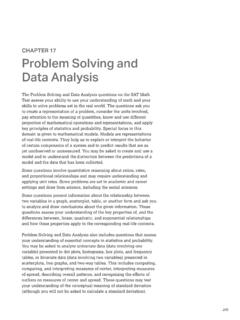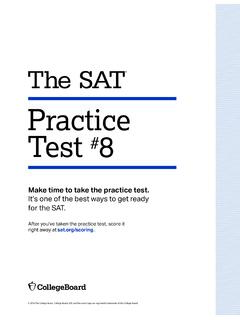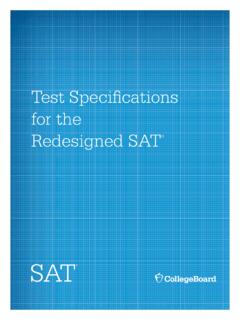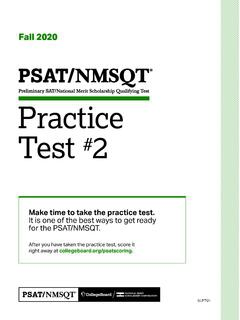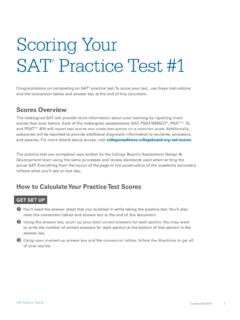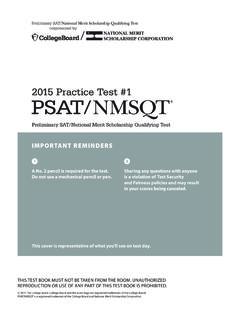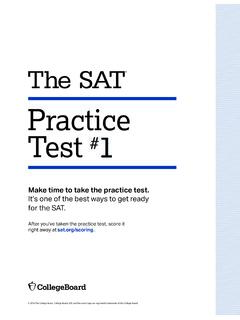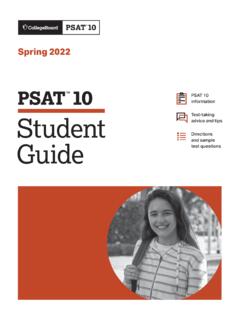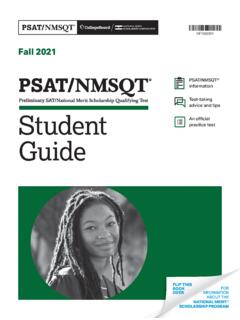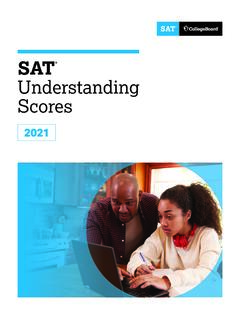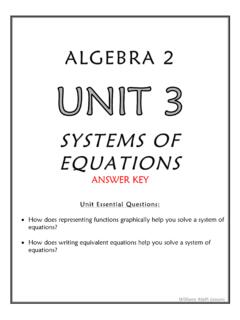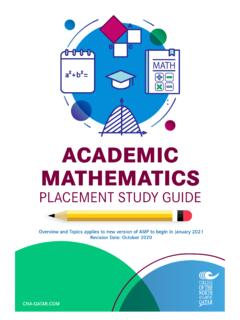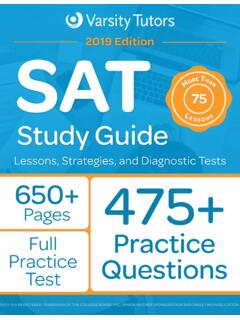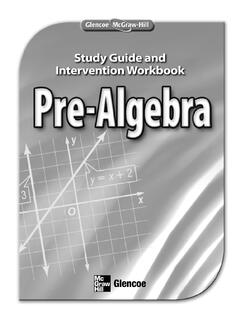Transcription of CHAPTER 15 About the SAT Math Test - SAT Suite of …
1 191 CHAPTER 15 About the SAT math TestFocus on math That Matters MostInstead of testing you on every math topic there is, the SAT math Test focuses on the topics you re most likely to encounter in college and career. The three areas of focus for math in the SAT are Heart of Algebra Problem solving and Data Analysis Passport to Advanced MathHeart of Algebra focuses on linear equations , systems of linear equations , and functions that are found in many fields of study. These questions ask you to create equations that represent a situation and solve equations and systems of equations as well as to make connections between different representations of linear solving and Data Analysis includes using ratios, percentages, and proportional reasoning to solve problems in real-world situations, including science, social science, and other contexts.
2 It also includes describing relationships shown graphically and analyzing statistical data. This group of skills is really About being quantitatively literate and demonstrating a command of the math that resonates throughout college courses, career training programs, and everyday two areas of math provide a powerful foundation for the math you will do in the to Advanced math is the third area of focus in the SAT math Test. The problems in this area focus on the math you will need to pursue further study in a discipline such as science or economics and for career opportunities in the STEM fields of science, technology, engineering, and math .
3 The Passport to Advanced math area requires familiarity with more-complex equations or functions, which will prepare you for calculus and advanced courses in on the SAT math Test are distributed among these three topics with 19 Heart of Algebra questions, 17 Problem solving and Data Analysis questions, and 16 Passport to Advanced math questions. The remaining six questions test your understanding of additional topics in math such as area, volume, circles, triangles, and 3 | Math192 The SAT math Test also contains questions in Additional Topics in math . Some of these problems focus on key concepts from geometry, including applications of volume, area, surface area, and coordinate geometry; similarity, which is another instance of proportional reasoning; and properties of lines, angles, triangles and other polygons, and circles.
4 There are also problems that focus on the fundamental ideas of trigonometry and radian measure, which are essential for study in STEM fields. Finally, there are problems involving the arithmetic of complex numbers, another concept needed for more-advanced study in math and the STEM SAT math Test requires a stronger and deeper understanding of a relatively small number of math topics that are especially relevant in college and in many the math Test AssessesThe SAT math Test assesses your understanding of mathematical concepts, your procedural skill and fluency in math , and your ability to apply those concepts and skills to real-world understanding and procedural skill and fluency are complementary.
5 Together, they lead to a thorough understanding of mathematical ideas and methods for solving problems. Questions on the SAT math Test assess these skills in various ways because the ability to use mathematical ideas and methods flexibly shows an understanding of math that can be applied to a wide variety of key to the relationship between fluency and conceptual understanding is recognizing and making use of structure. Recognizing structure allows you to understand mathematical relationships in a coherent manner and making use of it allows you both to apply these relationships more widely and to extend these relationships in useful ways.
6 Many of the examples and sample questions in the following chapters are more simply and deeply understood (and more quickly solved!) if you observe structure in the mathematics of the Grounded in Real-World ContextsThe SAT math Test features multistep problems with applications in science, social science, career scenarios, and other real-life contexts. In some cases, you will be presented with a scenario and then asked several questions related to the same context. You learn specific math skills in your math classes, and these skills are applied in your science and social studies classes.
7 When you use your mathematical skills outside of the math classroom, you are preparing for the is mentioned throughout this guide, the best preparation for the SAT is to work hard in your high school classes. Applying your math skills in your science and social studies classes will prepare you for many of the questions you ll come across on the SAT math 15 | About the SAT math Test193 The Makeup of the SAT math TestCalculator and No-Calculator PortionsThere are calculator and no-calculator portions on the SAT math Test. A calculator is a tool, and the ability to determine when to use it is a skill that you re expected to have.
8 In the calculator portion, many questions don t require a calculator and many questions can be completed faster without using a calculator. In general, the questions in the calculator portion are more complex than those in the no-calculator portion. Questions in the no- calculator portion emphasize your ability to do problems efficiently and re permitted to use a calculator on one portion of the SAT math Test, so be sure to bring a calculator with you to the test. However, many questions don t require a calculator and can actually be solved more quickly without one, so use careful judgment in deciding when to use should bring a calculator to use on the calculator portion of the SAT math Test.
9 A scientific or graphing calculator is recommended, and familiarity with your calculator may provide an advantage on some questions. Every question on the SAT can be solved without a calculator; however, strategically deciding when to use a calculator will reduce the time required to complete the test. Using a calculator can also help you avoid missing a question because of computation sure that you re very familiar with and comfortable using the calculator you bring with you on test day. Practice using the calculator you ll use on the test throughout your test and Gridded-Response QuestionsAbout 80% of the questions on the math Test are multiple-choice.
10 Each multiple-choice question consists of a question followed by four options. There is only one correct answer and there is no penalty for selecting an incorrect answer. Therefore, you should provide an answer to every question on the other questions on the math Test are gridded-response questions (also called student-produced response questions), and these questions make up About 20% of the test. The answer to each gridded-response question is a number (fraction, decimal, or positive integer) that you ll enter on the answer sheet into a grid like the one shown on the next page.
